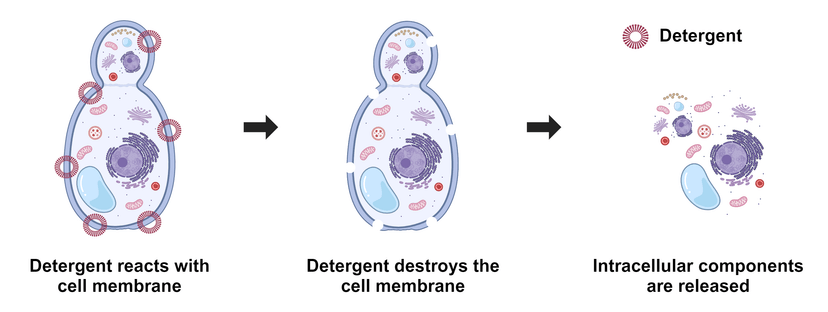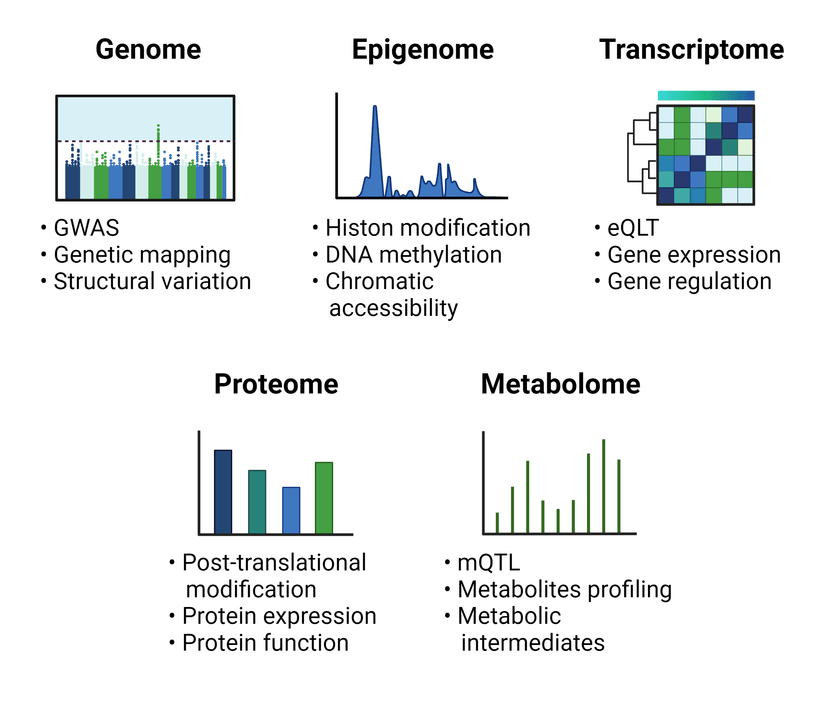Single Cell Omics
Omics is a broad term that refers to the study of cellular characteristics. Traditional omics biologics can be divided into branches, e.g., transcriptomics, genomics, proteomics, epigenomics, metabolomics, etc. Collectively, these omics methods have revolutionized molecular cell biology research. Single cell omics takes this research one step further and pertains to the profiling of single cells from a heterogeneous population of cells.
Significance of Single Cell Omics
Single cell omics studies help tie knowledge from genes, proteins, RNA, and microRNA (miRNAs), with epigenomic characterizations. In this way, a cell's phenotype can better be linked to genotype, allowing for normal development and disease processes to be studied and dissected at a single cellular level. Traditional biological research focuses on a tissue or cell population as a whole and ignores the characteristics of individual cells. Cells, however, are heterogeneous. Not only are there differences in cell phenotypes within a population, but also in their functions in transcriptional regulation, gene expression, and signal transduction.
By studying the involvement of cells on an individual level, single cell omics has helped enhance the understanding of cellular properties as well as the population architecture of a heterogeneous tissue. Technologies have been used to understand the mechanisms of gene regulation, protein expression, and epigenetic variation. By linking cell heterogeneity in health and disease, applications can be directed toward understanding the biology of disease and the therapeutic implications.
| Application Notes: |
General Workflow of Single Cell Isolation

Cell lysis refers to the breaking down of cells, and it is often used to analyze specific cellular compositions such as proteins, lipids, nucleic acids, reporter molecules, cell signal molecules, and other small biomolecules. Depending upon the detergents used, either all or some membranes are lysed. For single cell omics, the target is the nucleus.
- Once cells are separated in a suspension, they can be isolated by a number of techniques including flow cytometry, laser capture microdissection, serial dilution, coated magnetic beads, or microfluidic systems.
Note: More advanced isolation can be performed by droplet-based technologies which can uniquely barcode cells, thousands at a time. - After cells are isolated and/or barcoded, they are typically lysed. These gentle lysis methods dismantle the cell membrane without damaging the nuclear membrane, to keep the nucleus intact.
- The cell nucleus can be used as a substrate for genomic and epigenomic analysis, while the cytoplasmic lysate can be utilized for mRNA profiling.
Note: Additionally, some microfluidics-based methods offer the ability to physically separate cytoplasmic mRNA from nuclear genomic DNA (gDNA) of the same cell for targeted amplicon sequencing.
DNA and/or RNA can even be further amplified to provide single-cell whole-genome and whole-exome sequencing (scWGS and scWES) data. In essence, single cell omics technologies aim to study every part of an individual cell, from generating genomic data, to analyzing DNA methylome and transcriptome information.
Evolving Applications of Single Cell Omics
In the era of personalized medicine, single cell omics will be a powerful tool for the discovery and application of individualized therapies. In research, cancers have been extensively studied using single cell omics techniques. It has been shown that cancer development, progression, metastasis, and mortality rely on tumor heterogeneity. Often, the rare cell population rather than the dominant clones determine disease or tumor progression.
Note: Many populations of cells within separate tumors can vary in drug resistance, relapse, and metastasis.
Comprehensive single cell data sets generated by omics technologies may provide detailed maps to identify the biological basis for such differences within the tumor. Similarly, single cell sequencing can derive genome-wide profiles of the cells in individual tumors. Single cell omics studies may also provide a more suitable personalized approach to target and effectively treat individual cancer cells, either by killing the cell or reprogramming the cell's pathological features. Additionally, single cell omics may help uncover alternative routes to drug resistance in various cancers, which may contribute to adaptive and personalized therapies.
Single cell omics technologies will also be vital in the field of regenerative medicine. Stem cell therapy is a fast-growing area of research, and single cell heterogeneity among stem cell populations has been shown to determine cell fate decisions. To achieve successful stem cell reprogramming, understanding the underlying molecular pathways of differentiation and cell fate is essential.
Because of this, single cell omics also have the potential to further advances in reproductive medicine. Studies revolved around embryonic development may provide information to cell fate decisions, identity, and function in normal and/or abnormal development. Single cell transcriptomic studies of somatic tissues may aid in developing tools for the selection of healthy embryos that have the best chances of pregnancy. In addition, techniques may help to identify biomarkers associated with oocyte and embryo viability in relation to the influence of metabolites, RNA, or proteins.
| Application Notes: |
Product Ordering Information
Table 1. Lysis Buffers
| Cat# ▲ ▼ | Product Name ▲ ▼ | Unit Size ▲ ▼ |
| 24100 | ReadiUse™ bacterial cell lysis buffer *5X* | 10 mL |
| 20012 | ReadiUse™ mammalian cell lysis buffer *5X* | 10 mL |
| 60015 | ReadiUse™ Viral RNA Lysis Buffer | 50 mL |
| 24102 | ReadiUse™ Yeast Cell Lysis Buffer *5X* | 10 mL |
| 60012 | ReadiUse™ 10% Triton X-100 *Hydrogen Peroxide-and Carbonyl-Free* | 50 mL |
| 60000 | ReadiPrep™ Nuclear/Cytoplasmic Fractionation Kit | 50 Tests |
| 60005 | ReadiPrep™ Mitochondrial/Cytoplasmic Fractionation Kit | 50 Tests |
Table 2. Product ordering information for Nuclear™ LCS1 DNA stain.
| Product ▲ ▼ | Ex (nm) ▲ ▼ | Em (nm) ▲ ▼ | Unit Size ▲ ▼ | Cat. No. ▲ ▼ |
| Nuclear Blue™ LCS1 | 353 | 456 | 0.5 mL | 17559 |
| Nuclear Yellow [Hoechst S769121] *CAS 74681-68-8*[ | 372 | 504 | 0.5 mL | 17539 |
| Nuclear Violet™ LCS1 *5 mM DMSO Solution* | 401 | 460 | 0.5 mL | 17543 |
| Nuclear Green™ LCS1 *5 mM DMSO Solution* | 503 | 527 | 0.5 mL | 17540 |
| Nuclear Orange™ LCS1 *5 mM DMSO Solution* | 514 | 556 | 0.5 mL | 17541 |
| Nuclear Red™ LCS1 *5 mM DMSO Solution* | 622 | 645 | 0.5 mL | 17542 |
| Nuclear Red™ LCS2 *5 mM DMSO Solution* | 651 | 681 | 0.5 mL | 17545 |
Table 3. Ordering Info for RNA Quantifying Reagents Products
| Cat# ▲ ▼ | Product Name ▲ ▼ | Unit Size ▲ ▼ |
| 17610 | StrandBrite™ Green RNA Quantifying Reagent *200X DMSO Solution* | 1 ml |
| 17611 | StrandBrite™ Green RNA Quantifying Reagent *200X DMSO Solution* | 10 ml |
| 17655 | StrandBrite™ Green Fluorimetric RNA Quantitation Kit *Optimized for Microplate Readers* | 1000 Tests |
| 17656 | StrandBrite™ Green Fluorimetric RNA Quantitation Kit | 100 Tests |
| 17657 | StrandBrite™ Green Fluorimetric RNA Quantitation Kit *High Selectivity* | 100 Tests |
References
Chapter 1 - Single-Cell Omics: An Overview
The technological landscape and applications of single-cell multi-omics
Single-cell omics: A new direction for functional genetic research in human diseases and animal models
Multi-Omics of Single Cells: Strategies and Applications
Single-cell technologies: From research to application
